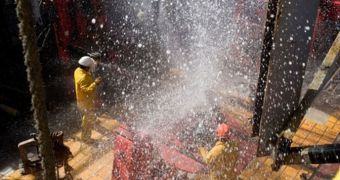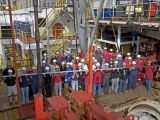At this point in time, the effects of global warming and climate change are becoming increasingly obvious, and researchers need to work together with authorities to produce valid science and policies, aimed at preventing devastating effects. But in order to do that, policymakers need to base their decisions on accurate model. For that to happen, scientists have to make the models, based on data collected from expeditions to some of the harshest places on the planet. Additionally, data can also be collected from the ocean floor, which was the goal of a recently concluded expedition.
Scientists with the Integrated Ocean Drilling Program (IODP) Expedition 317 recently concluded an eight-week stay off the coast of New Zealand, where they drilled a number of holes in the oceanic crust, in an attempt to collect more data on how the climate of the planet changed eons ago. The work was conducted from aboard the scientific drilling vessel JOIDES Resolution (JR), and the international team that was in charge of the expedition featured 34 scientists and 92 support staff. The IODP is funded primarily by the US National Science Foundation (NSF), and the Ministry of Education, Culture, Sports, Science, and Technology, in Japan.
During the course of the research, which spanned between November 4, 2009 and January 4, 2010, the team drilled a number of four holes in the ocean floor. One of the holes was deemed to be the deepest ever drilled by the JR vessel in a continental shelf, and was measured to have a depth of 1,030 meters (3,380 feet). A second hole was the deepest ever drilled during the course of a single expedition to sea, at a depth of 1,927 meters (or 6,322 feet). In addition to setting these records, the investigation also managed to accomplish its target, of collecting samples showing roughly 10 million years of sea level fluctuations records.
“This was one of only two JR expeditions that have attempted to drill on a continental shelf – this was not a routine operation for this ship,” shares University of Texas in Austin (UTA) expert Craig Fulthorpe. He was the co-chief scientist on the expedition, and also its leader, alongside colleague and co-chief scientist Koichi Hoyanagi, a professor at the Shinshu University, in Japan. “We never expected we would be able to drill this deep in such a difficult environment,” Fulthorpe states. In addition to waters off New Zealand, the IODP project also analyzed areas on the New Jersey coast, the Bahamas, Tahiti, and on the Marion Plateau off northeastern Australia.

 14 DAY TRIAL //
14 DAY TRIAL // 
